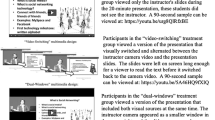Abstract
This study investigated the effects of instructor monitoring on student attitudes in an interactive television course. A comparison was made between learners located at sites with and without video feedback to the instructors. Data were collected for four variables: level of interaction as perceived by the student, value of the content taught, student assessment of gains in knowledge, and overall satisfaction. Multivariate analysis of variance (MANOVA) results indicated that student perceptions were not affected by the absence of video monitoring. The effect size was estimated to be practically zero and corroborated by the qualitative evidence collected in a subsequent study using interviews in other television (TV) courses. Findings were discussed in relation to instructional characteristics and system improvement priorities. The paper concluded that given appropriate instructional characteristics, partial absence of video feedback to the instructor may be adequately rectified to justify a wider coverage by interactive TV instruction even where real-time video feedback is not feasible.
Similar content being viewed by others
Explore related subjects
Discover the latest articles, news and stories from top researchers in related subjects.References
Campbell, D. T., and Stanley, J. C. (1966)Experimental and Quasi-Experimental Designs for Research. pp. 13–34. Chicago, IL: Rand McNally.
Clark, R. (1983) Reconsidering research on learning from media.Review of Educational Research 53(4), 445–59.
Clark, R. (1985) Confounding in educational computing research.Journal of Educational Computing Research 1(2), 137–48
Cohen, J. (1988)Statistical Power Analysis for the Behavioral Sciences (2nd edn). p22. Hillsdale, NJ: Lawrence Erlbaum.
Fulford, C. P., and Zhang, C. (in press) Constructing interactive reality in distance education TV.In the American Center for the Study of Distance Education (ACSDE) Monograph Series. University Park, PA: ACSDE.
Fulford, C. P. and Zhang, S. (1993) Perceptions of interaction: a critical predictor in distance education.American Journal of Distance Education 7(3), 8–21.
Fulford, C. P. and Zhang, S. (1994) Tooling up to go the distance: Video interaction analysis. In M.R. Simonson, N.J. Maushak and K.L. Abu-Omar (eds),16th Annual Proceedings of Selected Research and Development Presentations of the 1994 National Convention of the Association for Educational Communications and Technology. pp. 215–28, Nashville, TN.
Gunawardena, C. (1989) Current approaches to using communications technologies for delivering adult continuing/professional education. InProceedings of the 30th Annual Adult Education Research Conference. pp. 152–8, Madison, WI.
Hackman, M. Z. and Walker, K. B. (1995) Perceptions of proximate and distant learners enrolled in university-level communication courses: a significant non-significant finding.International Journal of Educational Telecommunication 1(1), 43–51.
Kozma, R. B. (1991) Learning with media.Review of Educational Research 61(2), 179–211.
Kozma, R. B. (1994) Will media influence learning? Reframing the debate.Educational Technology Research and Development 42(2), 7–19.
Nunnally, J. C. (1967)Psychometric Theory. pp. 559–650. New York: McGraw-Hill.
Oliver, E. L. (1994) Video tools for distance education. In B. Wills (ed.)Distance Education: Strategies and Tools, pp. 165–97. Englewood, NJ: Educational Technology Publications.
Richey, R. (1994, February) Developmental research: the definition and scope. Paper presented at the National Convention of the Association for Educational Communications and Technology, Nashville, TN.
Richmond, V., Gorham, J. and McCroskey, J. (1987) The relationship between selected immediacy behaviors and cognitive learning. In M. McLaughlin (ed.)Communication Yearbook 10, pp. 574–90, Beverly Hills, CA: Sage.
Rosenthal, R. and Rosnow, R. L. (1991)Essentials of Behavioral Research: Methods and Data Analysis (2nd edn). pp. 51–60. New York: McGraw-Hill.
Salomon, G. and Clark, R. (1977) Re-examining the methodology of research on media and technology in education.Review of Educational Research 47(1), 99–120.
Sholdt, G., Zhang, S. and Fulford, C. P. (1995) Sharing across disciplines — Interaction strategies in distance education, Part I: Asking and answering questions. In M.R. Simonson and M.L. Anderson (eds)m17th Annual Proceedings of Selected Research and Development Presentations at the 1995 National Convention of the Association for Educational Communications and Technology, Anaheim, CA, pp. 533–41.
Stevens, J. (1992) Applied Multivariate Statistics for the Social Sciences (2nd ed.). Lawrence Erlbaum, Hillsdale, NJ.
Suen, H. K. and Stevens, R. J. (1993) Analytic considerations in distance education research.American Journal of Distance Education 7(3), 61–9.
Tassie, T. (1994, February) Distance learning: What do the students think? Paper presented at the National Convention of the Association for Educational Communications and Technology, Nashville, TN.
Telesat Canada (1991)The Canadian Education Market Survey. Gloucester, ON: Telesat Canada.
Thompson, A. D., Simonson, M. R. and Hargrave, C. P. (1992)Educational Technology: A Review of Research. p. 17. Washington, DC: Association for Educational Communications and Technology.
Threlkled, R. and Brzoska, K. (1994) Research in distance education. In B. Willis (ed.)Distance Education: Strategies and Tools, pp. 41–66. Englewood Cliffs, NJ: Educational Technology Publications.
Wilcott, L. L. (1991, February) A qualitative study of teachers’ planning of instruction for adult learners in a telecommunications-based distance education environment. Paper presented at the Annual National Convention of the Association for Educational Communications and Technology, Orlando, FL.
Witherspoon, J. (1992) Teaching with computer communication, video, and print. Unpublished manuscript, San Diego State University.
Zhang, S. and Fulford, C. P. (1994) Interaction time and psychological interactivity: Are they the same thing in the TV classroom?Educational Technology 34(4), 58–64.
Author information
Authors and Affiliations
Rights and permissions
About this article
Cite this article
Zhang, S., Fulford, C.P. Two-way and one-way video: when is ‘no difference’ significant in distance education?. Educ Inf Technol 1, 227–238 (1996). https://doi.org/10.1007/BF02350660
Issue Date:
DOI: https://doi.org/10.1007/BF02350660




